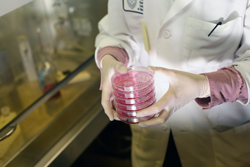Setting the standard for handling medical samples
In vitro research has contributed significantly to the fields of cellular and molecular biology, and consequently to many advances in medicine. However, progress is not as fast as it could be since many of the samples are not handled correctly prior to their analysis in the laboratory. Considerable funding from the Health research programme of FP7 has been earmarked to address this problem. Both private and public research organisations have committed to developing new standards and tools for in vitro diagnostics in the context of the Spidia project. Over 250 laboratories have been enlisted to participate in ring trials addressing DNA and RNA in blood and plasma samples. The results are expected to drive the development of guidance documentation on key issues such as quality assurance. In parallel, a new method of collecting and stabilising tissue samples has been created. Analysis of 3\;000 samples has demonstrated superior preservation in comparison to conventional techniques such as snap freezing, where the temperature is reduced as quickly as possible, and formalin fixation. Remarkably, the new technology allows both histopathological and molecular analyses to be performed on the same sample. Samples may travel great distances or be stored for long periods prior to their analysis. The advent of a tracking system, including both hardware and software, during Spidia will help organisations follow samples from the point of collection all the way until they are put under the microscope. A new container for storing and transporting tissue samples completes the picture. Finally, a search has been initiated for biomarkers that reveal whether or not the quality of a sample has been impaired during processing. Both RNA and metabolic profiles show promise in this area. No stone remains unturned as new sampling techniques and stabilisation solutions are also being sought. Fast adoption of the new technologies and standards is assured since the Spidia consortium includes a prominent pan-European standards body. The hope is that debilitating diseases, such as Alzheimer's, will be diagnosed earlier and with greater reliability.







